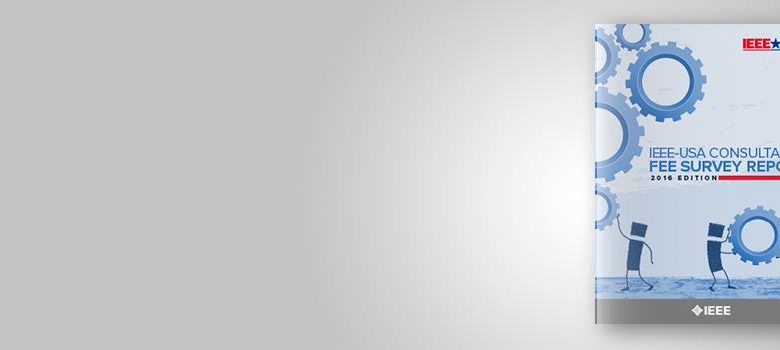
Engineering consultants who want to earn top dollar should head to the South Atlantic region; or, for a bit less, to the Pacific Coast. According to the 2016 IEEE-USA Consultants Fee Survey Report, those located in the coastal region – between the District of Columbia and Florida – report the highest median hourly rate at $180. Consultants in the three Pacific states charge $176, the second highest rate.
The median hourly rate consultants now charge is $167 – $17 (and 11%) more than the 2015 median rate. However, this increase may be because significantly more consultants reported that they’re charging $200, or more, an hour. Some 26% now charge this rate, up from 20% last year.
According to the survey, conducted this past spring, consultants have an average of 22 years in the profession, and 16 years of experience as consultants. Further, slightly more than two in five (42.4%) have been consulting for 25 years, or more. The average consultant age rose to 57 this year, up about two years from the 2015 report.
Similar to the general IEEE membership, the vast majority of consultants are male (95%). Most (88%) identified themselves as non-Hispanic white, while the largest minority group among consultants is Asian or Pacific Islander, at 5.2%. This percentage is up almost one point from last year. Only 1.9% said they are Hispanic; this percentage is down more than one point from 2015. Just 1% identified themselves as African-American. Almost 90% (89.4%) of the respondents are United States citizens by birth, and another 7.4% are naturalized citizens. As with 2015 results, 2.1% are permanent resident aliens.
Education is clearly a factor in how much consultants charge. In the 2016 survey, those holding a Ph.D. have a $51 advantage in their median hourly rate of $218. The median differential for Ph.Ds. increased $32 from last year’s report. Those with an MSEE or MSCE had an average rate of $154, down $6 from last year. Interestingly, consultants with a BSEE or BSCE had a median hourly rate of $155, a dollar more than those with a master’s in engineering.
Consistent with the 2015 report, median hourly rates are nearly the same for those consultants with and without Professional Engineer (P.E.) licenses. The median rate for those with a P.E. license was $169, and $165 for those without one. The last report to indicate a significant difference was in 2014, showing a $21 an hour advantage for those with a P.E. license.
Logically, more experience should translate to higher hourly rates. However, as with the 2015 report, the 2016 findings show some flattening across experience levels. The typical consultant, who has been in the profession for less than 15 years, reported an hourly rate of $167 an hour. Those with 35 or more years of experience reported the highest median hourly rate of $172, only modestly more than those with less experience. But trend moves upward, when the data centers on the number of years as a consultant – instead of years in the profession. The typical rate begins at $132 an hour, for those with less than five years of consulting experience. It increases to $191, after 25 years. The second figure reflects a $59 increase in median earnings for those who have that amount of consulting experience.
Sectors and lines of business also influence consultants’ hourly rates. Those who consult for utilities charge a median of $171; while those whose clients are in private industry – both defense, other than defense and utilities – reported the same median hourly rate of $161.
Among the lines of business with sufficient responses, the most lucrative for consultants are electrical/electronic services, with a median hourly rate of $177. The median rate for utilities as a line of business matches utilities as a sector, at $171. Top areas in which respondents offer consulting services include systems engineering (39%), project management (33%) and electrical power systems (28%). Two lines of business were both 25% – management and software development/application/management.
As with the last two reports, more than two-thirds (68.4%) of respondents have a home office. Almost half (49.9%) of them have professional liability insurance coverage, in case of errors and/or omissions. The average consultant billed 29 hours per week. A substantial amount of the average consultant’s business comes from repeat clients – some 57.4%. But having outside connections is important, as significant earnings also come from referrals (12.5%), as well as networking (11.9%).
The 2016 IEEE-USA Consultants Fee Survey Report analyzes responses using the U.S. Census Bureau Regions, not IEEE Region designations. Thus, when looking at consultants’ median hourly fees, those living in the South Atlantic and Pacific regions have the highest median hourly fees, at $180 and $176, respectively. Consultants in the West South Central Region (Texas, Oklahoma, Arkansas and Louisiana) charged $169 an hour, roughly the same as the $167 group median. The medians for the other Census Regions in this report were all less than the group median.
IEEE-USA has conducted compensation surveys of U.S. members since 1972. Separate surveys of consultants’ compensation began in 1998. This past spring, 11,884 U.S. IEEE members identified as consultants in the IEEE membership database were invited by email to complete the 2016 IEEE-USA Consultants Fee Survey. Of this number, 974 participated, for an 8% response rate.
The findings in this report represent the 568 individuals who indicated that 50% or more of their consulting hours came from working independently, with partners or incorporated. IEEE Strategic Research conducted the survey and prepared the report based on the 568 responses.
The 2016 IEEE-USA Consultants Fee Survey Report is available at shop.ieeeusa.org for $29.95 to members and $49.95 to non-members.






